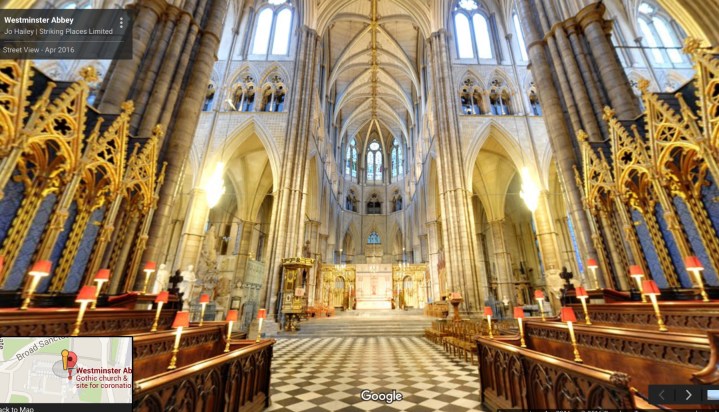
It’s also on the itinerary of many international tourists who’re keen to see up close the stunning architecture and experience the magical atmosphere of this famous London church, one with a history stretching back more than a thousand years.
For curious types who don’t have the time or money to make the trip – or for those nearby who simply want to skip the abbey’s £20 (about $26) entrance fee – Google’s Street View tool once again comes to the rescue.
As much as we enjoyed entertaining the idea of a camera-equipped Street View car edging through the abbey’s Great West Door, tootling up the nave and making a sharp right at the altar, no such shenanigans took place.
Instead, Google teamed up with 360-degree-photography specialist Striking Places for the project. The team, led by Striking Places director Jo Hailey, gathered imagery of the impressive Gothic structure across five sessions between September and Christmas last year.
You can view the imagery via Street View, or by heading directly to Westminster Abbey’s website. We recommend the latter, as you can click through to various features such as the Coronation Chair, the Grave of the Unknown Solider, and the tomb of Mary Queen of Scots, with accompanying notes offering background information for each location inside the abbey.
Commenting on the results of the project, John Hall, the Dean of Westminster Abbey, said, “I’m delighted that this new collaboration will enable people from Timbuktu to Kalamazoo and beyond to see and learn so much more than previously about the magnificence and significance of this great and beautiful church.”
For some Street View projects where Google’s unable to use its camera-laden cars, the company makes use of its so-called “Trekker” backpacks. The more portable technology has been used to gather imagery for the Grand Canyon, the ancient site of Machu Picchu in Peru, and the interior of the world’s largest passenger plane, among other places. Want to learn more about the latest content to hit Street View? Then check out DT’s other related stories here.
[This article has been updated to reflect the involvement of Striking Places.]


